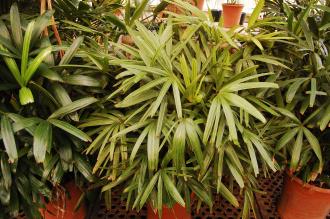
Rhapis excelsa ‘Chiyodazuru’ (16/01/2016, Kew Gardens, London)
Position: Indirect bright to medium light
Flowering period: N/A
Soil: Moist, well drained
Eventual Height: 3m
Eventual Spread: 3m
Hardiness: 9b, 10a, 10b, 11, 12, 13
Family: Arecaceae
Rhapis excelsa ‘Chiyodazuru’ is an evergreen multi stemmed Fan Palm with a clump forming habit. Its dark green leaves have narrow stripes, are arranged radially, palmately, composed of up to 13 segments and up to 80cm across. Its leaflets are lanceolate with finely serrulate margins, up to 40cm long and 7cm across. Its stems are covered in a persistent sheath of brown fiber which appears to be woven in a square mesh pattern.

Rhapis excelsa ‘Chiyodazuru’ Leaf (16/01/2016, Kew Gardens, London)
The species Rhapis excelsa, commonly known as Slender Lady Palm or Lady Palm, is native to south China. In its native habitat it grows as an understory plant in tropical woodland.
The etymological root of the binomial name Rhapis is derived from the Greek rhapis meaning ‘needle’. Excelsa is derived from the Latin excelsior meaning ‘ever upward’.
The landscape architect may find Rhapis excelsa ‘Chiyodazuru’ useful conservatory or atrium palm with attractive foliage.
Ecologically, Rhapis excelsa ‘Chiyodazuru’ is of little value to UK wildlife
The Royal Horticultural Society have given the species Rhapis excelsa their prestigious Award of Garden Merit in 1993.

Rhapis excelsa ‘Chiyodazuru’ Stem (16/01/2016, Kew Gardens, London)
Rhapis excelsa ‘Chiyodazuru’ prefers moist, fertile, well-drained soils. It tolerates most pH of soil.
When maintaining Rhapis excelsa ‘Chiyodazuru’ as a houseplant its soil should be watered regularly. Watering should be reduced during the winter months. Its preferred active growing temperature rages from between 20ºc to 30ºc. Feeding with weak fertiliser solution should be carried out once a month during the growing season. Red Spider Mites and Scale Insects may attack this plant.

Landscape Architecture

